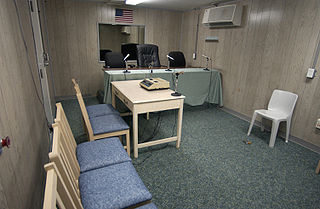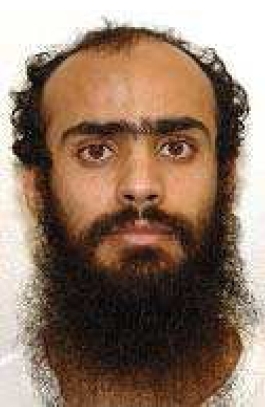
The Combatant Status Review Tribunals (CSRT) were a set of tribunals for confirming whether detainees held by the United States at the Guantanamo Bay detention camp had been correctly designated as "enemy combatants". The CSRTs were established July 7, 2004 by order of U.S. Deputy Secretary of Defense Paul Wolfowitz after U.S. Supreme Court rulings in Hamdi v. Rumsfeld and Rasul v. Bush and were coordinated through the Office for the Administrative Review of the Detention of Enemy Combatants.

Camp Iguana is a small compound in the detention camp complex on the US Naval base at Guantánamo Bay, Cuba. Camp Iguana originally held three child detainees, who camp spokesmen then claimed were the only detainees under age 16. It was closed in the winter of 2004 when the three were sent back to their native countries.
Abu Bakker Qassim is a Uyghur from China's western frontier, Xinjiang Uyghur Autonomous Region who was held in the United States Guantanamo Bay detention camps, in Cuba. His Guantanamo Internment Serial Number was 283.
The Khalden training camp was one of the oldest and best-known military training camps in Afghanistan. It was located in the mountains of eastern Paktia Province, near to Tora Bora.
Sadik Ahmad Turkistani is an ethnic Uyghur born and raised in Taif, Saudi Arabia and an opponent of the Taliban. Held by the Taliban in Kandahar prison in Afghanistan, he was briefly freed when they were overthrown in late 2001.
Adil Kamil Abdullah Al Wadi is a citizen of Bahrain who was held in extrajudicial detention in the United States Guantanamo Bay detainment camps, in Cuba. Al Wadi's Guantanamo Internment Serial Number was 60. American intelligence analysts estimate that Al Wadi was born in 1964, in Muharraq, Bahrain.
Adel Noori is a Uyghur refugee who was wrongly imprisoned for more than 7 years in the Guantanamo Bay detention camps in Cuba. His Guantanamo Internment Serial Number was 584. Joint Task Force Guantanamo counter-terrorism analysts report that he was born on November 12, 1979, in Xinjiang, China.
Haji Mohammed Ayub is a citizen of China, who was held in extrajudicial detention in the United States Guantanamo Bay detention camps, in Cuba. The Department of Defense reports he was born on April 15, 1984, in Toqquztash, China.
Adel Abdulhehim or Adel Abdul Hakim is a citizen of the People's Republic of China from the Uighur ethnic group. He was held in extrajudicial detention in the United States-controlled Guantanamo Bay detainment camps in Cuba.Joint Task Force Guantanamo counter-terrorism analysts report he was born on October 10, 1974, in Ghulja, Xinjiang.
Ahmad Tourson or Ahmad Abdulahad, is a Uyghur refugee unlawfully detained for more than seven years in the United States Guantanamo Bay detainment camps. The detention occurred despite becoming clear early on that he was innocent. The Department of Defense reports that Tourson was born on January 26, 1971, in Xinjiang Province, China, and assigned him the Internment Serial Number 201. Tourson is one of approximately two dozen detainees from the Uighur ethnic group.
Dawut Abdurehim is a Uyghur refugee best known for the more than seven years he spent in the United States Guantanamo Bay detention camps, in Cuba. Abdulrehim is one of 22 Uighurs who have been held in Guantanamo for many years despite it becoming clear early on that they were innocent.
Starting in 2002, the American government detained 22 Uyghurs in the Guantanamo Bay detainment camp. The last 3 Uyghur detainees, Yusef Abbas, Hajiakbar Abdulghupur and Saidullah Khali, were released from Guantanamo on December 29, 2013, and later transferred to Slovakia.
Sami Abdul Aziz Salim Allaithy Alkinani is an Egyptian professor who was held in the Guantanamo Bay detention camps, in Cuba. His Guantanamo Internment Serial Number was 287. Analysts reported that he was born on October 28, 1956, in Shubrakass Egypt. He was repatriated to Egypt on September 30, 2005. He was later classified by the United States Department of Defense as a no longer enemy combatant.
Abdallah Saleh Ali Al Ajmi was a Kuwaiti citizen, who was held in extrajudicial detention in the United States Guantanamo Bay detainment camps, in Cuba. His Guantanamo Internment Serial Number was 220. Joint Task Force Guantanamo counter-terrorism analysts reports indicated that he was born on 2 August 1978, in Almadi, Kuwait.

Mohammed Ahmed Said Haidel is a citizen of Yemen, who was held in extrajudicial detention in the United States Guantanamo Bay detention camps, in Cuba. His Guantanamo Internment Serial Number is 498. Joint Task Force Guantanamo counter-terrorism analysts estimate that he was born in 1978, in Ta'iz, Yemen.
Fethi Boucetta is a citizen of Algeria, who was held in extrajudicial detention in the United States Guantanamo Bay detention camps, in Cuba. His Guantanamo Internment Serial Number was 718. The Department of Defense reports that he was born on September 15, 1963, in Algiers.

Ali Ahmad Muhammad Al Rahizi is a citizen of Yemen who was held in extrajudicial detention in the United States Guantanamo Bay detainment camps, in Cuba. His Guantanamo Internment Serial Number is 45. Joint Task Force Guantanamo counter-terrorism analysts reports he was born on October 13, 1979, in Taiz, Yemen.
No Longer Enemy Combatant (NLEC) is a term used by the U.S. military for a group of 38 Guantanamo detainees whose Combatant Status Review Tribunal (CSRT) determined they were not "enemy combatants". None of them were released right away. Ten of them were allowed to move to the more comfortable Camp Iguana. Others, such as Sami Al Laithi, remained in solitary confinement.
Edham Mamet is a Uyghur refugee best known for the more than seven years he spent in the United States Guantanamo Bay detention camps, in Cuba. He was captured in Afghanistan in November 2001. Edham Mamet is one of the 22 Uighurs held in Guantanamo for many years despite the fact that it became clear early on that they were innocent.
No-Hearing Hearings (2006) is the title of a study published by Professor Mark P. Denbeaux of the Center for Policy and Research at Seton Hall University School of Law, his son Joshua Denbeaux, and prepared under his supervision by research fellows at the center. It was released on October 17, 2006. It is one of a series of studies on the Guantanamo Bay detention center, the detainees, and government operations that the Center for Policy and Research has prepared based on Department of Defense data.



